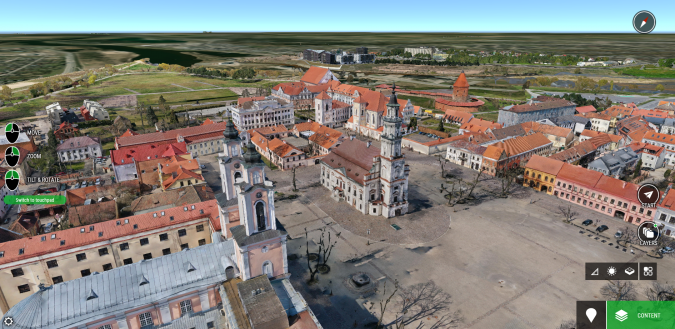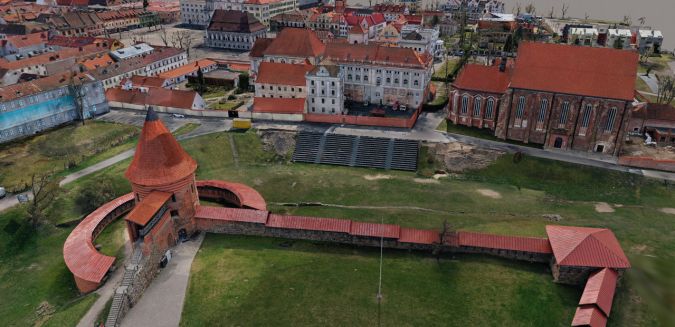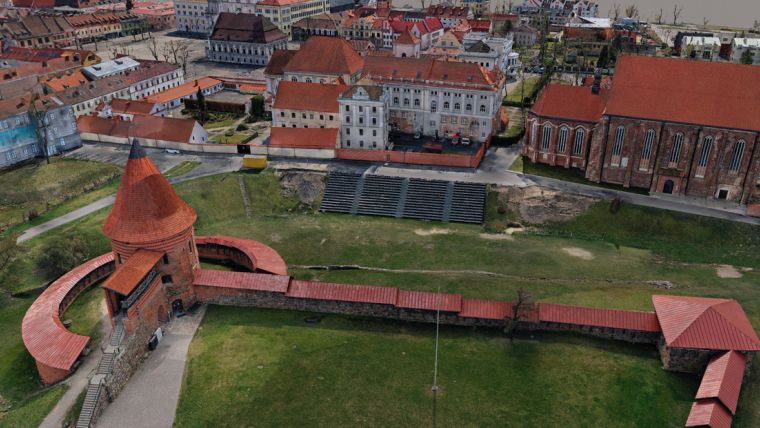Digital twin of Kaunas stretches from campus to Old Town
The city of Kaunas, Lithuania, is leveraging a digital twin model to help with city planning. This 3D model uses data from the city infrastructure, such as traffic and weather, to assess how changes in the city will affect its citizens. It is also being used to generate simulations of what the city could look like under various scenarios. The digital twin model is set to provide a deeper understanding of the city and helping Kaunas prepare for the future.
In recent years, Lithuania has set ambitious goals for improving the emissions performance of its building stock. The roughly 661,000 structures in the Eastern European country are subject to rigorous national emissions performance requirements specified in Lithuania’s building codes. An estimated 75% of these buildings were constructed before 1992 and have poor energy performance. The national building stock, including many Soviet-era structures, emits roughly 5.3 metric tons of carbon dioxide per year.
As laid out in Lithuania’s long-term renovation strategy, approved in 2021, all these structures must be updated to improve energy performance by 2050. This plan is in line with the European Union’s 2018 directive to address the energy performance of aging buildings and infrastructure, including the decarbonization of the national building stock.
With this use case in mind, Kaunas University of Technology’s (KTU’s) Centre for Smart Cities and Infrastructure has created the Kaunas City digital twin, a digitization of the university campus’ built environment. The digital twin also stretches beyond the campus into Kaunas, Lithuania’s second-largest city, offering 3D visualization of Old Town Kaunas.
Integrating multiple digitization methods
KTU’s Centre for Smart Cities and Infrastructure used Bentley’s OpenCities Planner software as its main platform, allowing for the integration of various digitization technologies to enable multiple use cases for a digital twin – from energy performance simulations to real-time air quality monitoring.
For example, using Bentley’s ContextCapture software intended for UAV-based reality modeling, KTU created a thermophotogrammetry model of KTU’s campus area, which will be intended to analyze the heat loss of aging buildings and estimate the future heat loss of buildings still in the planning stages.
This functionality has already proven useful to the university as it considers renovations of buildings on its own campus. However, according to Darius Pupeikis, head of the Centre for Smart Cities and Infrastructure, this use could be expanded to buildings in Kaunas and beyond, both in Lithuania and internationally.
“We will have an opportunity to assess the heat loss of an entire block or district of buildings almost in real-time, that’s why it could be quite an interesting technology,” Pupeikis explained.

Real-time sensor data
Furthermore, the digital twin includes a 'smart campus' - a concept that uses a combination of reality capture, Internet of Things (IoT) and building information modeling (BIM) technologies to show and tag real-time sensor data on air quality and other conditions affecting human health within buildings at KTU. The smart campus also incorporates visualization functionality to display and simulate the shadowing effects of installed photovoltaic solar panels, showing where these units may face obstacles to producing their maximum energy output.
As the Kaunas City digital twin serves as an example for how aging buildings can be altered to prioritize energy efficiency, the centre is also using digital twin technology to create 3D models of abandoned heritage buildings in tandem with Lithuania’s Public Department of Heritage. They are digitizing historic structures now so that, even as these heritage buildings experience wear and tear or collapse in the years to come, they will be digitally preserved and may eventually be authentically renovated in a manner faithful to history. This effort includes buildings such as the Church of the Transfiguration of the Lord in Kaunas, which is listed in Lithuania’s Register of Cultural Values.
“We have many heritage subjects. We need to find technologies that digitize Cathedral-Basilica of St. Peter and St. Paul, and a customs building at Latvia’s and Lithuania’s border, because each day, erosion causes destruction for those buildings,” Pupeikis said.
The function of the digital twin model has also been tested during the process of erecting new buildings. Currently, the center is using a digital twin to monitor the construction of KTU’s new MLab, a prototyping lab on campus. Using the capabilities of the BIM model developed by Bentley’s OpenBuildings Designer software, KTU can ensure safe conditions through all stages of construction, from laying foundations to topping out the building’s fourth floor.

Digital sandbox
Aside from its practical uses for energy efficiency monitoring and infrastructure upkeep, the Kaunas City digital twin also offers a rich tool for students’ development as they move into careers that are increasingly digitally focused. Students studying architecture at KTU, for example, have the opportunity to see their own projects reflected in a digital twin.
“Our civil engineering and architecture students can accommodate the project and educate themselves by using this platform. This digitized environment is like a sandbox for our students,” Pupeikis added.
The digital twin also enables virtual campus tours, using 360-degree panorama technology to take users inside 19 of KTU’s facilities, giving them a peek inside classrooms, libraries, labs, dorms and other spaces. Students or other users can even click on facilities and devices to learn information, such as what kind of equipment might be available in each lab or classroom.
This 'sandbox' is not just open to KTU students and faculty, but the larger Kaunas community as well. In the future, Pupeikis imagines that citizens could use the Kaunas City digital twin or a similar tool to view municipal projects that are under construction, thus empowering civic participation in Kaunas and beyond.

Value staying current with geomatics?
Stay on the map with our expertly curated newsletters.
We provide educational insights, industry updates, and inspiring stories to help you learn, grow, and reach your full potential in your field. Don't miss out - subscribe today and ensure you're always informed, educated, and inspired.
Choose your newsletter(s)












